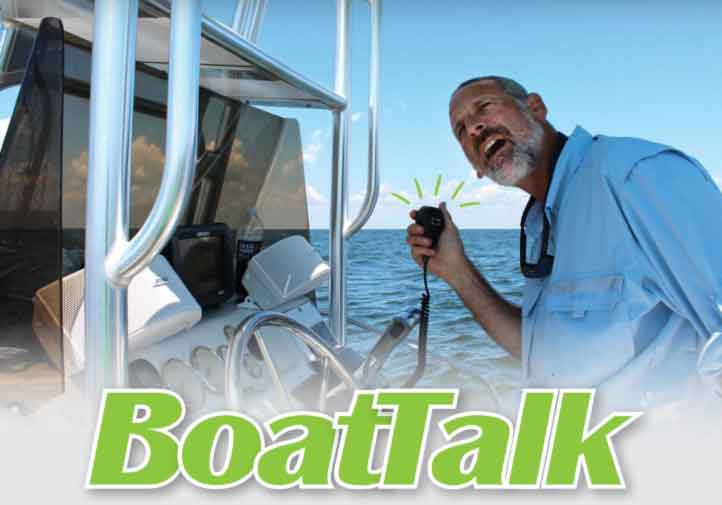Shhh… if you listen closely, you can hear your fishing boat talking. It’s trying to tell you something. Yes, your boat does have the power to communicate with you — but only if you’re willing to listen.

Bolts and washers securing the steering arm to the actuator on many outboards have been known to complain in an audible fashion, by making a very squeaky-belt-like sound when they come loose and the pieces-parts start rubbing back and forth against each other. Listen closely if something sounds like a squeaking belt but you can just barely hear it, especially at very low (vibration-rich) RPM ranges, and use your ears to pinpoint the source. If you think it’s this link that’s on the blink, tighten those bolts up in a wink — the problem will only get worse until the bolt falls off and you lose steering completely. And yes, if that bolt does fall off it’ll likely fall overboard and end up in the… (ahem) drink.
HOwling sounds coming from the propeller are your boat trying to tell you that the trim is set too high, and the prop is sucking air. Ventilation (as opposed to cavitation, which causes vibration as well as an audible noise) makes a very distinct sound that’s louder and deeper than the engine’s usual hum. It’s important to listen for this, because ventilation can cause a drop in speed, your engine to overheat, and/or a loss of power and control in sharp turns. When you hear that howl, take the trim down a notch.
SqueAking noises coming from a place where two pieces of molded fiberglass are joined is a sure sign of loosening fasteners. When you hear these squeaks, identify the exact location or seam where they’re created. Then check screws, through-bolts, and other fasteners for tightness. The same is true of T-top legs where they meet and are affixed to the deck or console. Finally, if your boat has a cabin you may hear the same tell-tale squeaking from cabinetry that’s loosened and is rubbing at the joints.
PiTter-patter sounds from above on your hard top or T-top can mean any number of things: an antenna may have fallen down, the radome may have lost a bolt and started bumping against the mount, or perhaps a wire to the running lights came free and is tapping the top. Whatever the cause, when you hear a sound from above you need to stop and investigate. Since the top of a hard or T-top is out of sight and out of mind, it’s common for things like backed-out screws or corroding connections to go unnoticed up there, and that sound you hear may be the only way you’ll ever know there’s a problem until something important (like that radar or that running light) fails to work.
VirTually every outboard has audible alarms, and when they go off, obviously you need to listen up. In the case of engines that don’t have digital displays, however, you’ll need to use your eyes as well as your ears to determine what the issue is. Audible beeps combined with the speed or number of times a light flashes will often communicate the specific problem. If you don’t know what those beeps and flashes are trying to tell you, write down how many beeps and how many flashes there are and then reach for your smartphone — the answer can almost always be found on Google.
Air idle intake valves can get cloggy, and when this happens your boat will tell you by stalling out at low RPM, yet running just fine at elevated RPM. When you hear that stall every time you pull the throttle back, you’ll know there’s a good chance this is the issue. If it happens while you’re far from the dock, to get home start in neutral with the throttle advanced and keep RPM up at around 1800 or 2000. Then quickly shift back to neutral and then straight into forward gear, and right back up to 2000 or so RPM in one swift motion. Yes, this is hard on the transmission and no, you certainly don’t want to make a habit out of it. But the technique will keep the engine running so you can make it back to the dock.
FueL restrictions will tip you off with audible surging that you hear from your engine, even as the throttle remains static. A kink or leak in the lines, clogged filter(s), a closed or plugged tank vent, or a virtually empty fuel tank can all cause that sound. Note: if there’s water or contaminants in the fuel there usually won’t be a surge, but instead a sudden shut-down.
WaKe-jumping can cause the engine to over-rev, which makes an unmistakable change in the engine’s pitch. That’s your boat telling you that you’re going too fast for the conditions. What if you hear a sudden over-rev while traveling on calm waters? It could be the result of “spinning out” the hub of your propeller. When that rubber insert inside the hub gives way, RPM often shoots through the roof. In some cases you may be able to back off on the throttle, let the rubber get a fresh grip, and then get moving again. But if you get this lucky, don’t push it and try to go fast because once the hub spins it’s bound to happen again and the problem will only grow worse. Instead, go home slowly as you count your blessings.
Listen up as you cruise from hotspot to hotspot, and you will, in fact, hear your fishing boat talking to you. Wait a sec — shhhh — I think I hear it right now. It’s saying “come on, grab your rods and let’s go.”